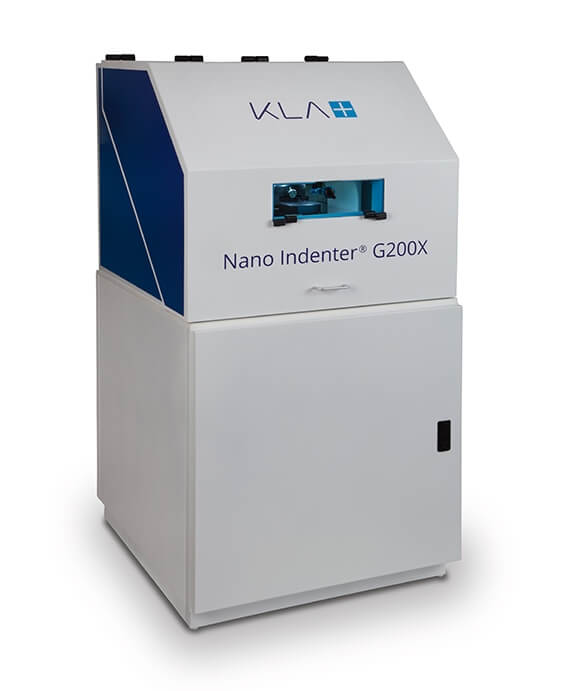
Nanoindenter
Innovation History
Nano Instruments, Inc. releases the first commercially available nanoindenter, called the Nano I.
The first commercially available nanoindenter, the Nano I system, is released by Nano Instruments, a company formed by the inventors of nanoscale mechanical testing technology, Dr. Warren Oliver and Sir John Pethica. The core technology of the force-displacement nanoindenter includes electromagnetic actuation, chosen for its unmatched stability, combined with a 3-parallel plate capacitor to measure displacement. This superior technology has withstood the test of time and is used today in KLA nanoindentation systems.
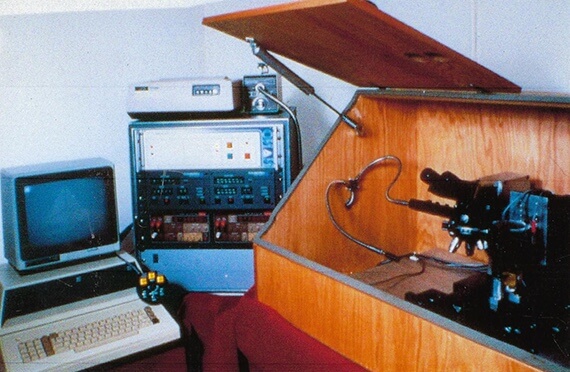
Dr. Warren Oliver and Sir John Pethica are awarded a patent for the Continuous Stiffness Measurement (CSM) technique, representing the biggest innovation in nanomechanical testing.
The Nano Indenter® II is released with a new Continuous Stiffness Measurement (CSM) technique for dynamic nanoindentation. Dr. Warren Oliver and Sir John Pethica are awarded a patent for the CSM technique, which enables continuous measurement of hardness and modulus as a function of depth. This measurement technique also allows the user to extract dynamic mechanical analysis (DMA) data from indentation tests. The CSM technique remains the single biggest innovation in the nanoindentation field since the development of the first nanoindenter.
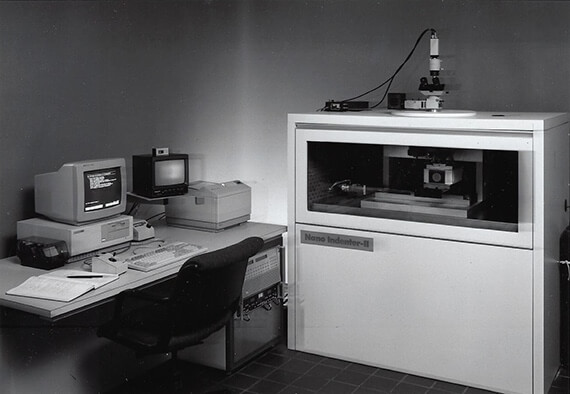
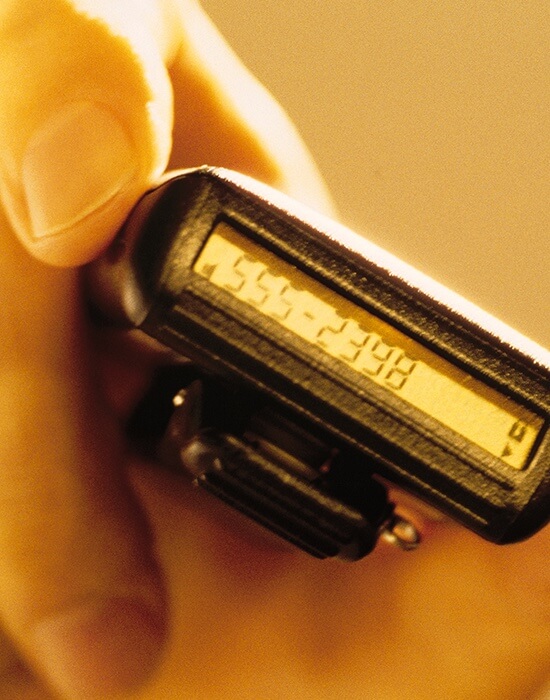
Nano Instruments introduces a High Load actuator capable of indentation loads up to 5000mN.
Dr. Warren Oliver and Dr. George Pharr publish an article that will be cited more than 22,000 times.
Dr. Warren Oliver and Dr. George Pharr publish “An improved technique for determining hardness and elastic modulus using load and displacement sensing indentation experiments” in the Journal of Materials Research. This paper lays the foundation for measuring nanoscale mechanical properties of hardness and elastic modulus. This seminal work enables semiconductor manufacturers to prevent failure in thin films by quantitatively linking processing parameters with the mechanical strength and flexibility of the film. The same year, Nano Instruments introduces a lateral force measurement option, enabling surface profiling and 3D topographic mapping of indentations.
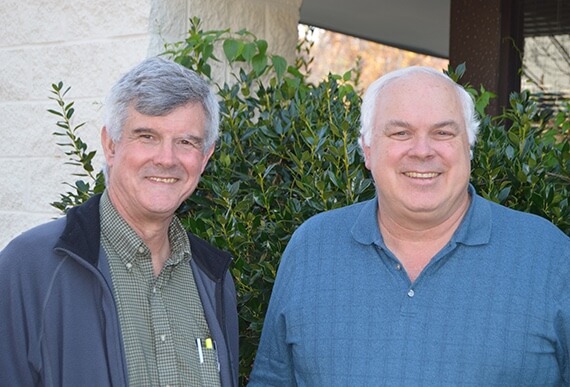
Click here to read the original paper
An improved technique for determining hardness and elastic modulus using load and displacement sensing indentation experiments.
Enhanced optics bring Nomarski Interference Contrast and brightfield/darkfield imaging to the Olympus microscope used on the Nano Indenter II to help users find measurement features on low contrast samples.
Nano Instruments, Inc. launches the affordable Nano Indenter IIs system for the razor-blade industry by redesigning the actuator and simplifying the optics.
Nano Instruments opens new headquarters in Oak Ridge, Tennessee.
The Nano Indenter XP launches with the new XP Head actuator, which continues to be in production to this day. This new actuator technology streamlines measurement setup, and improved load-frame stiffness reduces systematic error while expanding the range of indentation.
The Dynamic Contact Module (DCM) enables ultra-low-load indentation to enable testing of polymers and other viscoelastic materials. Ultra-low-load nanoindentation is made possible by the low mass and high resonant frequency of the DCM actuator.
MTS Systems Corp. acquires Nano Instruments, Inc.
MTS releases a high temperature option: a 100°C test chamber designed to enclose the entire Nano Indenter XP system.
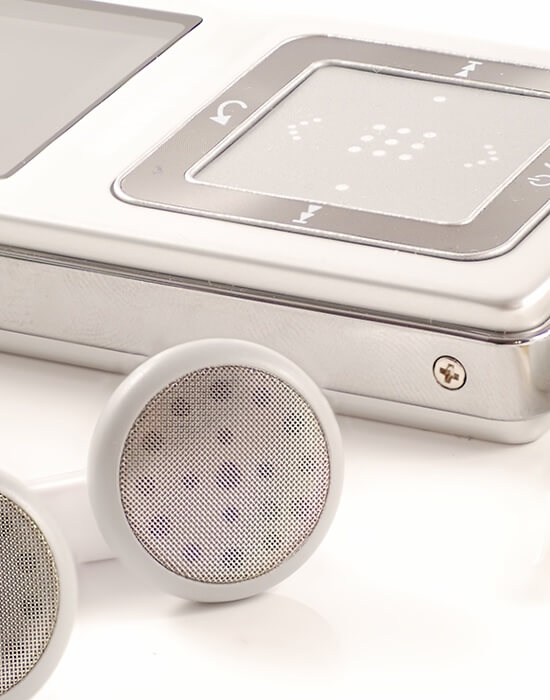
The release of TestWorks software for the Nano Indenter XP brings a modern Windows-based operating system to nanoindenter operation and data analysis.
MTS introduces several new products, including a 300mm wafer test system, the Nano Indenter XPW; a compact benchtop system, the Nano Indenter SA2; and an integrated imaging system, the Nano Tribology Workstation.
The NanoUTM is released to measure tensile properties of fibers, finding a unique application in measuring spider silk.
The NanoUTM and NanoBionix instruments are released, designed for measuring the tensile properties of fine single fibers. This application is rapidly adopted by the spider-silk industries because of its ability to link the genome of many spider species to the mechanical properties of their silk. The NanoUTM generates interest from advanced textile research and development engineers because it can quantify viscoelastic properties of polymer microfibers at constant strain rates up to 400%.
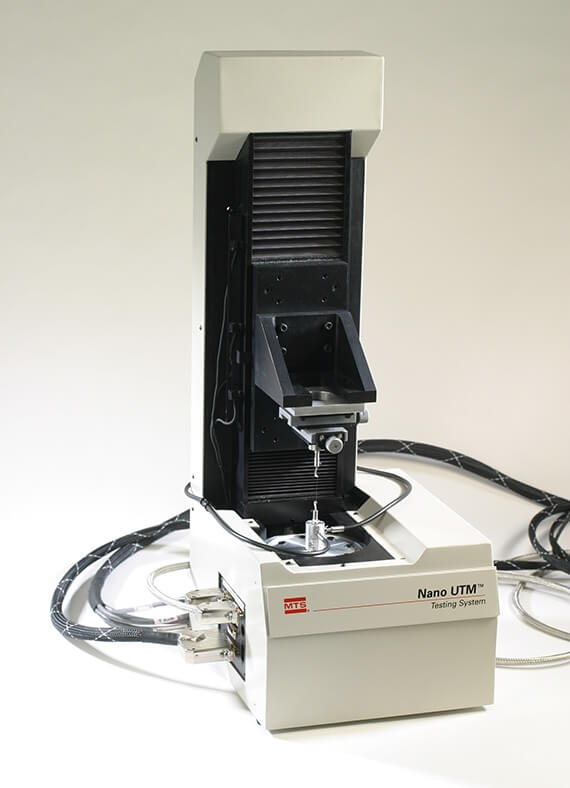
Learn more about our latest tool offerings in this product series:
The Nano Indenter XP platform is enhanced with a 200°C hot stage and improved optics.
The NanoVision feature is added to the product portfolio, enabling basic scanning probe microscopy using the indenter tip and a high-resolution piezo nanopositioning stage.
The Nano Indenter G200 is the first ISO 14577 compliant nanomechanical tester.
The Nano Indenter G200 is the first commercially available nanoindenter designed to comply with the ISO 14577 standard, the international standard for instrumented indentation testing. The system can measure high loads up to 10N, bridging the gap between nanoindentation and Vickers hardness testing. Lateral force measurement capability enables scratch and wear testing. Large samples can be measured with a 200mm by 200mm sample stage. The NIDAQ Expansion system allows users to read and control external devices, enabling the addition of third-party cameras and other sensors, such as temperature and humidity.
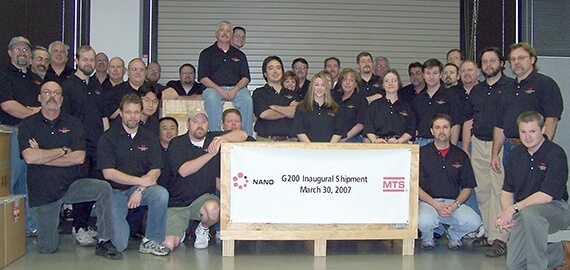
Learn more about our latest tool offerings in this product series:
Agilent Technologies acquires the Nano Indenter group from MTS Systems, releasing new products for in situ nanoindentation testing and dynamic mechanical analysis.
Agilent Technologies acquires the Nano Indenter group from MTS Systems. As one of its first actions, the Nano Indenter group at Agilent releases the InSEM I for in situ nanoindentation testing. This system is designed to allow the DCM head to be positioned inside a scanning electron microscope (SEM). Drs. Erik Herbert, Warren Oliver, and George Pharr develop a process for measuring dynamic properties of viscoelastic materials via nanoindentation, replacing a traditional process that required measuring bulk material properties with a dynamic mechanical analyzer (DMA). This industry-first small-scale DMA technique extends nanoindentation testing to rubber and gel materials, quantifying interactions at interfaces and degradation across elastomer layers. For example, measurement of multiple layers of polymers enables tire manufacturers to achieve more accuracy by measuring the final product, rather than bulk materials.

Learn more about our latest tool offerings in this product series:
Nanomechanics, Inc. is founded by Dr. Warren Oliver, John Swindeman and Kermit Parks to bring high quality nanoindentation to new markets.
Agilent releases the DCM II for the Nano Indenter G200 system, introducing expanded force capacity, improved durability, and enhanced ease of use.

Nanomechanics, Inc. launches the industry’s first high temperature in-situ nanoindenter, the InSEM HT system, with a maximum temperature of 300°C.
The temperature range of the InSEM HT system is extended to 500°C. Nanomechanics also launches Express Test, a revolutionary high-speed nanoindentation technique that maps mechanical properties and provides statistical sampling of material constituents.
Nanomechanics releases the iNano®, the industry’s most affordable, compact nanoindenter, along with the NanoFlip, a high performance in situ system.
The new iNano is the first affordable, compact and user-installable nanoindenter from Nanomechanics. The iNano introduces improved actuator InForce50 and controller technology, coupled with a software package focused on ease-of-use. The NanoFlip utilizes the same innovative technology as the iNano in a form factor that enables highly stable in-situ measurements.
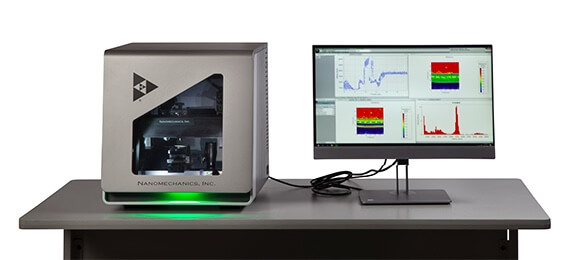
Keysight Technologies is spun off from Agilent Technologies, taking with it the nanoindenter product line.
Nanomechanics, Inc. releases the iMicro nanoindenter, providing extended force range with the new InForce 1000 actuator. Nanomechanics also introduces NanoBlitz™ 3D technology, high-speed nanoindentation for mapping mechanical properties.
Nanomechanics extends the NanoBlitz 3D technique by adding Continuous Stiffness Measurement (CSM) capability. Used together, these technologies can measure mechanical properties as a function of volume, i.e. mechanical property tomography. The InSEM HT temperature range is extended to 800°C.
Nanomechanics releases the Gemini 2-axis isometric indentation system for tribology, wear, and single-asperity testing. Gemini is the only actuator that senses and applies force along both axes, with equivalent resolutions, allowing true nano-tribology and the ability to measure Poisson’s ratio.
KLA-Tencor Corporation acquires the nanoindenter product group at Keysight Technologies and Nanomechanics, Inc.
The Nano Indenter G200X is released by KLA, based on the Nano Indenter G200 and featuring significant improvements to performance and ease-of-use.
The KLA Nano Indenter G200X is faster than its predecessor, the G200, with higher performance and accuracy. New features of the KLA nanoindenter include DataBurst™ impact hardness testing, with a 100kHz data acquisition rate, enabling hardness measurements at strain rates exceeding 10^4/s.
